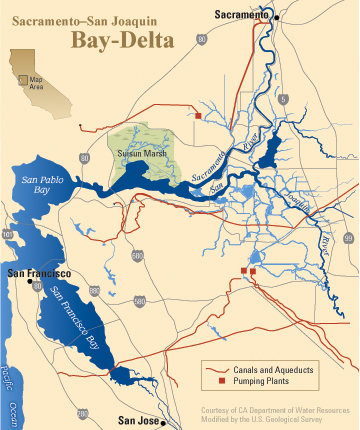
California Delta Smallies
The Sacramento-San Joaquin River Delta, or California Delta, is an expansive inland river delta and estuary in Northern California in the United States. The Delta is formed at the western edge of the Central Valley by the confluence of the Sacramento and San Joaquin rivers and lies just east of where the rivers enter Suisun Bay. The Delta is recognized for protection by the California Bays and Estuaries Policy. The city of Stockton is located on the San Joaquin River on the eastern edge of the delta. Source
In this excerpt from a great article on Fishingworld.com, Troy Lindner talks about California Delta smallmouth bass. Since we don’t read much about California bronze, I wanted to share this with you. Good stuff!
Troy Lindner on Tidal Rivers
Winner of countless bass tournaments in California and Arizona, rising star Troy Lindner has become a student of the grandiose waterbody that is the California Delta. Comprised of nearly 1,000 miles of waterways, the Delta encompasses rivers such as the Sacramento, American and San Joaquin. While the fishery is unique, it’s far from the only tidal river system hosting smallmouth bass. There’s the Columbia River and several others along the West Coat, while the East Coast has the Delaware, James Penobscot and many more.
Lindner says that the key to finding fall smallmouths in these dynamic systems is to seek out some of the smaller sloughs and backwaters that harbor the clearest water possible. “Beginning in late September and continuing through early winter,” says Lindner, “I like to find banks blanketed with sizeable submerged trees and other woody cover. In a tidal river environment, the active bass often lie on the up-current side of cover. So if it’s an incoming tide, smallmouths position on that side of the tree. Between tides when water stops moving, bass turn tough. But once the outgoing tide commences, bass reposition on the other, current-facing side of the cover and start to bite again.”
Once he’s uncovered a potential slough with ample cover, Lindner goes right to work with one of his favorite smallmouth baits: a Rapala Skitterwalk. “The topwater calls whole schools of clear water bass out of cover. The first few casts are vital, the ones in which the bigger fish usually bum rush the bait.”
After he’s taken several fish on the Skitterwalk, Lindner scales down presentation, opting for a finesse lure, such as a 4-inch TriggerX tube rigged on a VMC Tube Jig. If more fish remain in the vicinity, he’ll swim a tube to extract additional bites. “In the Delta,” he quips, “there’s always another spot to try, and always more bass to hunt. It’s a fishing paradise, that’s what I love about it.” Source
This is only one excerpt from this excellent article. The rest of the article goes in depth about Great Lakes rivers and Mississippi River smallmouth fishing.
Please click LIKE to pass this article on and don’t forget to sign up to our newsletter here: click



